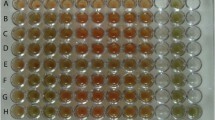Abstract
The susceptibility of 211 viridans streptococci isolated from blood cultures to eight antimicrobial agents was determined. All the isolates were susceptible to cefotaxime, ceftriaxone, imipenem and vancomycin. Thirty eight percent of the isolates were resistant to penicillin (MICs ≥0.25 µg/ml). Tetracycline resistance was found in 41 % of the isolates and in 7 % of these strains tetracycline resistance was combined with erythromycin resistance. FiveStreptococcus mitis isolates exhibited increased (MIC 64 µg/ml and 128 µg/ml) or high-level (MIC ≥500 µg/ml) resistance to gentamicin, kanamycin and tobramycin. Four of these isolates were also resistant to penicillin (MICs 16–32 µg/m). In vitro synergy was not demonstrated for combinations of penicillin and gentamicin against threeStreptococcus mitis isolates with gentamicin MICs of 1000, 128 and 64 µg/ml. Results of this study indicate the importance of monitoring antibiotic resistance trends in viridans streptococci particularly with respect to penicillin and aminoglycoside resistance.
Similar content being viewed by others
References
Goldfarb J, Wormser GP, Glaser JH: Meningitis caused by multiply antibiotic-resistant viridans streptococci. Journal of Pediatrics 1984, 105: 891–895.
Faber BF, Eliopoulos GM, Ward JI, Rouff KL, Syriopoulou V, Moellering RC: Multiply resistant viridans streptococci: susceptibility to β-lactam antibiotics and comparison of penicillin-binding protein patterns. Antimicrobial Agents and Chemotherapy 1983, 24: 702–705.
Van den Berg IS: The emergence of penicillin resistance in nasopharyngeal and oral isolates ofStreptococcus pneumoniae and viridans streptococci following beta-lactam antibiotic exposure. MSc Dissertation, University of the Witwatersrand, 1990.
Moellering RC: The Garrod Lecture. The enterococcus: a classic example of the impact of antimicrobial resistance on therapeutic options. Journal of Antimicrobial Chemotherapy 1991, 28: 1–12.
Cowan ST: Cowan and Steele's manual for the identification of medical bacteria. Cambridge University Press, Cambridge, 1974, p. 137–180.
Facklam RR, Washington JA:Streptococcus and related catalase-negative gram-positive cocci. In: Balows A, Hausler WJ, Herrmann KL, Isenberg HD, Shadomy HJ (ed): Manual of clinical microbiology. American Society for Microbiology, Washington, DC, 1991, p. 250–251.
Price T, French GL, Talsania H, Phillips I: Differentiation ofStreptococcus sanguis andS. mitior by whole-cell rhamnose content and possession of arginine dihydrolase. Journal of Medical Microbiology 1986, 21: 189–197.
National Committee for Clinical Laboratory Standards: Methods for dilution antimicrobial susceptibility tests for bacteria that grow aerobically. M7-A2. Approved Standard. NCCLS, Villanova, PA, 1990.
National Committee for Clinical Laboratory Standards: Methods for determining bactericidal activity of antimicrobial agents. M26-P. Proposed guideline. NCCLS, Villanova, PA, 1987.
Washington JA: Functions and activities of the area committee on microbiology of the national committee for clinical laboratory standards. Clinical Microbiology Reviews 1991, 4: 150–155.
Winstanley TG, Wilcox MH, Spencer RC: Combined resistance to erythromycin and tetracycline in streptococci. Journal of Antimicrobial Chemotherapy 1991, 28: 154–156.
Horaud T, Le Bouguenec C, Pepper K: Molecular genetics of resistance to macrolides, lincosamides and streptogramin B in streptococci. Journal of Antimicrobial Chemotherapy 1985, 16, Supplement A: 111–135.
Klugman KP, Koornhof HJ: Drug resistance patterns and serogroups or serotypes of pneumococcal isolates from cerebrospinal fluid or blood, 1979–1986. Journal of Infectious Diseases 1988, 158: 956–964.
Eliopoulos GM, Faber BF, Murray BE, Wennersten C, Moellering RC: Ribosomal resistance of clinical enterococcal isolates to streptomycin. Antimicrobial Agents and Chemotherapy 1984, 25: 398–399.
Faber BF, Eliopoulos GM, Ward JI, Rouff KL, Moellering RC: Resistance to penicillin-streptomycin synergy among clinical isolates of viridans streptococci. Antimicrobial Agents and Chemotherapy 1983, 24: 871–875.
Author information
Authors and Affiliations
Rights and permissions
About this article
Cite this article
Potgieter, E., Carmichael, M., Koornhof, H.J. et al. In vitro antimicrobial susceptibility of viridans streptococci isolated from blood cultures. Eur. J. Clin. Microbiol. Infect. Dis. 11, 543–546 (1992). https://doi.org/10.1007/BF01960811
Issue Date:
DOI: https://doi.org/10.1007/BF01960811




